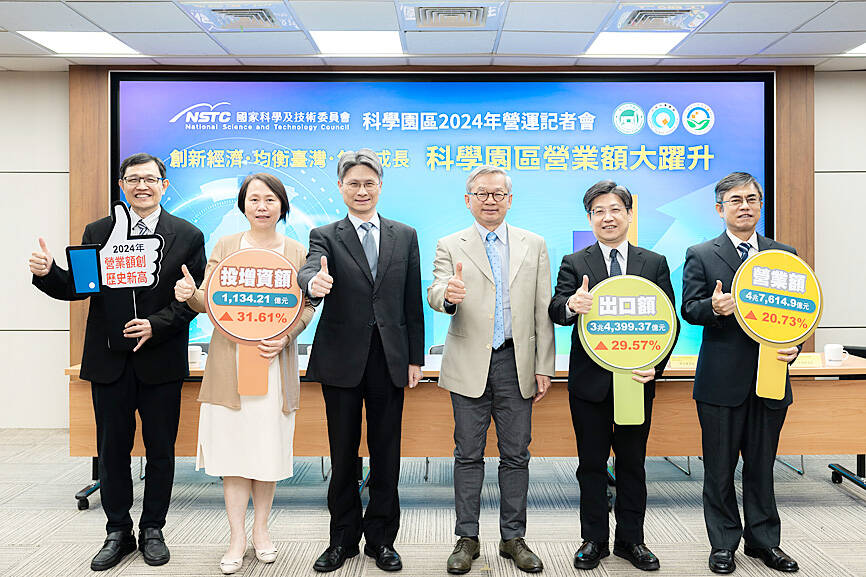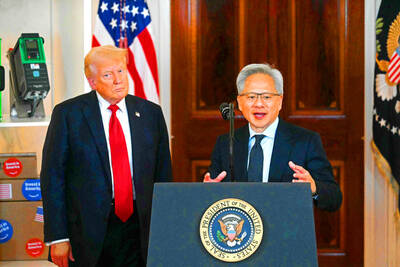The nation’s three major science parks posted record combined revenue of NT$4.76 trillion (US$144.41 billion) for last year, up 20.73 percent year-on-year, the National Science and Technology Council said in a report yesterday.
The council attributed the strong performance to rising demand for emerging technologies such as artificial intelligence (AI) and the end of inventory adjustments throughout the global semiconductor supply chain, the report said.
Combined revenue of firms at Hsinchu Science Park (新竹科學園區) increased 6.66 percent annually to NT$1.51 trillion, Central Taiwan Science Park (中部科學園區) posted revenue growth of 10.22 percent to NT$1.04 trillion and Southern Taiwan Science Park (南部科學園區) grew 39.55 percent to NT$2.21 trillion, the council said.

Photo courtesy of the National Science and Technology Council
Southern Taiwan Science Park’s revenue exceeded the NT$2 trillion mark for the first time, spurred by a higher sales contribution by semiconductor firms led by Taiwan Semiconductor Manufacturing Co (TSMC, 台積電), it said.
Regarding TSMC’s plans to construct 11 new production lines in Taiwan this year, the council is planning the second phase of expansion at Central Taiwan Science Park’s Taichung campus as a possible site for the chipmaker’s new investment at home, National Science and Technology Council Minister Wu Cheng-wen (吳誠文) told a news conference in Taipei.
“The government would continue to assist TSMC’s development in Taiwan” in terms of land, labor and utility, Wu said.
TSMC is expected to start mass production of chips using advanced node technologies at Hsinchu Science Park’s Baoshan (寶山) campus and Southern Taiwan Science Park’s Kaohsiung campus, while it plans to produce next-generation, cutting-edge 1.4-nanometer chips, he said.
Last year, the three science parks exported a combined NT$3.44 trillion of goods, up 29.57 percent from a year earlier, as the AI boom helped drive shipments of advanced chips and emerging-technology products, the report said.
At the same time, the combined imports of the three parks rose 35.33 percent to NT$2.4 trillion as a result of companies continuing to build factories and expand production, which boosted purchases of precision machinery and equipment from abroad, it said.
Overall, the three parks saw two-way trade increase 31.88 percent year-on-year to NT$5.84 trillion last year, also a new high, it added.
Of the parks’ six major industries, the IC industry was top in terms of revenue, rising 25.4 percent year-on-year to NT$3.81 trillion, followed by the optoelectronics industry with an increase of 6.89 percent to NT$439.04 billion, the report said.
Revenue of the computer and peripherals industry grew 8.02 percent to NT$224.35 billion, precision machinery industry sales rose 15.03 percent to NT$144.97 billion and the biotechnology industry reported sales were up 9.64 percent to NT$46.5 billion, it said.
However, revenue of the communications industry decreased 25.11 percent to NT$74.71 billion, as geopolitical tensions pushed firms to adjust their supply chain deployment, the report said.
The council said it anticipates a steady increase in the parks’ revenue this year on the back of the continued development of advanced process technologies and AI applications, despite uncertainties created by tariffs policies and other protectionist trade measures of US President Donald Trump’s administration, as well as the persistent shadow of geopolitical risks.

Taiwan Semiconductor Manufacturing Co (TSMC, 台積電) last week recorded an increase in the number of shareholders to the highest in almost eight months, despite its share price falling 3.38 percent from the previous week, Taiwan Stock Exchange data released on Saturday showed. As of Friday, TSMC had 1.88 million shareholders, the most since the week of April 25 and an increase of 31,870 from the previous week, the data showed. The number of shareholders jumped despite a drop of NT$50 (US$1.59), or 3.38 percent, in TSMC’s share price from a week earlier to NT$1,430, as investors took profits from their earlier gains

AI TALENT: No financial details were released about the deal, in which top Groq executives, including its CEO, would join Nvidia to help advance the technology Nvidia Corp has agreed to a licensing deal with artificial intelligence (AI) start-up Groq, furthering its investments in companies connected to the AI boom and gaining the right to add a new type of technology to its products. The world’s largest publicly traded company has paid for the right to use Groq’s technology and is to integrate its chip design into future products. Some of the start-up’s executives are leaving to join Nvidia to help with that effort, the companies said. Groq would continue as an independent company with a new chief executive, it said on Wednesday in a post on its Web

CHINA RIVAL: The chips are positioned to compete with Nvidia’s Hopper and Blackwell products and would enable clusters connecting more than 100,000 chips Moore Threads Technology Co (摩爾線程) introduced a new generation of chips aimed at reducing artificial intelligence (AI) developers’ dependence on Nvidia Corp’s hardware, just weeks after pulling off one of the most successful Chinese initial public offerings (IPOs) in years. “These products will significantly enhance world-class computing speed and capabilities that all developers aspire to,” Moore Threads CEO Zhang Jianzhong (張建中), a former Nvidia executive, said on Saturday at a company event in Beijing. “We hope they can meet the needs of more developers in China so that you no longer need to wait for advanced foreign products.” Chinese chipmakers are in

POLICY REVERSAL: The decision to allow sales of Nvidia’s H200 chips to China came after years of tightening controls and has drawn objections among some Republicans US House Republicans are calling for arms-sale-style congressional oversight of artificial intelligence (AI) chip exports as US President Donald Trump’s administration moves to approve licenses for Nvidia Corp to ship its H200 processor to China. US Representative Brian Mast, the Republican chairman of the US House Committee on Foreign Affairs, which oversees export controls, on Friday introduced a bill dubbed the AI Overwatch Act that would require the US Congress to be notified of AI chips sales to adversaries. Any processors equal to or higher in capabilities than Nvidia’s H20 would be subject to oversight, the draft bill says. Lawmakers would have